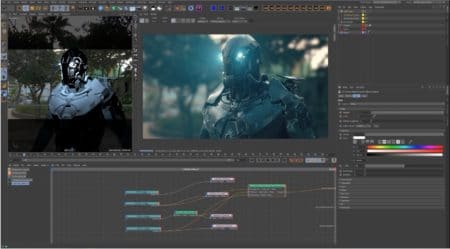Back in December, 2019, Autodesk announced the release of Arnold 6 with Arnold GPU.
Meet the New Arnold
Arnold’s intuitive interface makes it easy to toggle between CPU and GPU rendering, maintaining the same settings with a single click. Arnold GPU is based on NVIDIA’s OptiX framework and optimized to take advantage of NVIDIA RTX technology.
“Rendering workloads continue to grow as content providers strive to meet rising audience expectations for content quality. Speed and interactivity have become more crucial than ever to the creative process. Arnold 6 delivers performance gains that will help lighten the load with the same high-quality render results that the CPU renderer is known for,” said Chris Vienneau, senior director, Media & Entertainment Products, Autodesk. “We’ve worked closely with NVIDIA to optimize Arnold GPU to run on the latest RTX GPUs and RTX Server, and we’re excited to get this latest update into the hands of new and existing Arnold customers.”
“Arnold GPU powered by NVIDIA RTX GPUs will help graphics professionals work faster, meet tight deadlines, and explore new ideas during the creative process,” said Richard Kerris, Industry General Manager for Media & Entertainment, NVIDIA, “Autodesk was the first company to commit to RTX for their Arnold renderer, and we think artists are going to be blown away by the new interactivity, flexibility, and unmatched speed of final rendering using GPUs in Arnold 6.”
First unveiled as a beta release in March, Arnold 6 completes the Arnold GPU toolset with improvements across lights, shaders, and cameras, as well as on-demand texture loading and support for Open Shading Language (OSL) and OpenVDB volumes. Additionally, as part of Autodesk’s continued efforts to accelerate the adoption of open standards, a collection of components for Arnold in the USD ecosystem is now available online.
Arnold 6 highlights include:
- Unified Renderer – switches seamlessly between CPU and GPU rendering
- Lights, Cameras and more – Arnold GPU now supports OSL, OpenVDB volumes, on-demand texture loading, most LPEs, lights, shaders, and cameras. GPU noise is now also on par with CPU noise when using adaptive sampling, which has been improved to yield even faster, more predictable results regardless of the renderer used
- Optimized for NVIDIA RTX hardware – takes advantage of the latest technology to scale up rendering power when production demands it
- New USD Components – Hydra render delegate, Arnold USD procedural, and USD schemas for Arnold nodes and properties are now available on GitHub
- Performance Improvements – Several improvements help maximize efficiency and performance, including faster creased subdivisons, an improved Physical Sky shader, and dielectric microfacet multiple scattering
Arnold 6 with Arnold GPU
Arnold 6 with Arnold GPU is available as a standalone subscription or with a collection of end-to-end creative tools within the Autodesk Media & Entertainment Collection. For the first time, monthly, annual, and 3-year single-user subscriptions of Arnold are available on the Autodesk e-store. Arnold GPU is also available to try with a free 30-day trial of Arnold 6. Arnold GPU is available in all supported plug-ins for Autodesk Maya, Autodesk 3ds Max, Houdini, Cinema 4D, and Katana. For more information, visit https://www.autodesk.




Reader Comments
Probably a few things. It’s slow relative to Redshift probably because it’s beta and not fully optimized yet, but also because it’s unbiased and Redshift is biased. Meaning, and this is a huge oversimplification, that Redshift cheats calculations to optimize, and Arnold doesn’t.
GPU is slow relative to the CPU also because beta, but also because part of the benefit of GPU renderers is that it’s much easier to scale GPUs than CPUs. This test is indicative of one CPU vs one GPU as reviewed in https://redbytesite.com. It’s much easier (and hugely less expensive) to slap 4 GPUs in your box than 4 CPUs.
Probably a few things. It’s slow relative to Redshift probably because it’s beta and not fully optimized yet, but also because it’s unbiased and Redshift is biased. Meaning, and this is a huge oversimplification, that Redshift cheats calculations to optimize, and Arnold doesn’t.
GPU is slow relative to the CPU also because beta, but also because part of the benefit of GPU renderers is that it’s much easier to scale GPUs than CPUs. This test is indicative of one CPU vs one GPU as reviewed in https://redbytesite.com. It’s much easier (and hugely less expensive) to slap 4 GPUs in your box than 4 CPUs.
Probably a few things. It’s slow relative to Redshift probably because it’s beta and not fully optimized yet, but also because it’s unbiased and Redshift is biased. Meaning, and this is a huge oversimplification, that Redshift cheats calculations to optimize, and Arnold doesn’t.
GPU is slow relative to the CPU also because beta, but also because part of the benefit of GPU renderers is that it’s much easier to scale GPUs than CPUs. This test is indicative of one CPU vs one GPU as reviewed in https://redbytesite.com. It’s much easier (and hugely less expensive) to slap 4 GPUs in your box than 4 CPUs.
Comments are closed.